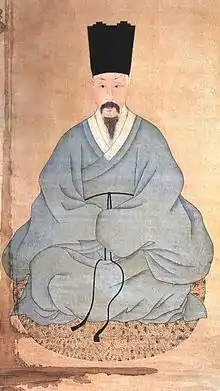Gim Manjung
Gim Manjung (1637–1692) was a Korean novelist and politician of the mid-Joseon period. He was eminent Neo-Confucian scholars of the Joseon period.
| Gim Manjung | |
 | |
| Korean name | |
|---|---|
| Hangul | 김만중 |
| Hanja | |
| Revised Romanization | Gim Manjung |
| McCune–Reischauer | Kim Manjung |
| Pen name | |
| Hangul | 서포 |
| Hanja | |
| Revised Romanization | Seopo |
| McCune–Reischauer | Sŏp'o |
| Courtesy name | |
| Hangul | 중숙 |
| Hanja | |
| Revised Romanization | Jungsuk |
| McCune–Reischauer | Chungsuk |
Life and work
A member of the yangban class, Kim passed the state civil service examination and rose through the official ranks to become a royal academic counselor and minister during the reign of King Sukjong. He was exiled twice for involvement in the political factionalism of the time[1] As a man of letters his most renowned works were the novels Sassi Namjeonggi ("Record of Lady Sa's Trip to the South" 謝氏南征記) and The Nine Cloud Dream Kuunmong ("The Cloud Dream of the Nine" 九雲夢). The former is a novel about family affairs set in China, but it is also a satirical depiction of the political reality of his day, and in particular a rebuke of King Sukjong. The latter is one of the most prominent novels of traditional Korea. It is said that Kim wrote the Kuunmong during his second exile from political life.[2] It is an ideal novel dealing with the affairs of life and is centered on the travails of the hero. It has a highly Buddhist overtone, with an emphasis on the transience of worldly glory and pleasure. Heinz Insu Fenkl's new translation of Kuunmong is available from Penguin Classics.
See also
References
- Tai-jin Kim. 1976. A Bibliographic Guide to Traditional Korean Sources. Seoul: Asiatic Research Center, 351.
- Tai-jin Kim. 1976. A Bibliographic Guide to Traditional Korean Sources. Seoul: Asiatic Research Center, 356.